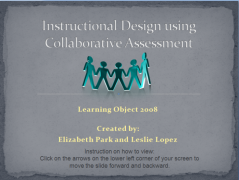
Background information:
The isolation of online learning often makes it difficult for students to articulate when they may be having difficulties in a course. The online instructor may not learn until the course is over that student satisfaction was low. Therefore, a collaborative assessment process integrated in online learning improves student and instructor relationships and online community by clearly identifying similarities and differences in course satisfaction and engagement. Online collaborative evaluations can be an effective instructional design and evaluation strategy to enhance student learning and introduce content design. Traditionally, instructors are evaluated at the end of the course and instructors are usually not participants in the collaborative evaluations. This can be due to ethical considerations that student's grade could be compromised if the instructor was given negative feedback or in other words, fear of retaliation. Hess (2008) suggests that in designing a course, if students and teachers can collaborate, it will be valuable to both parties involved. Since online collaborative learning places an emphasis on the instructional design, content delivery, and student engagement and satisfaction, collaborative course assessment will enhance the instructional design. In addition, according to a recent study, identifying students as "authentic evaluators" meets standards-based guidelines and assists students in improving their professional skills.
The target population for collaborative assessment is the online instructor at an Institute of Higher Education (IHE). Ideally the online instructor would have a background in the course management system he/she is using. In addition, the assumption is that the online instructor would have had some experiences in online discussions prior to administering a collaborative online course evaluation.

What is online instructional design?
Instructional Design is creating instructional tools and segmenting content to help support learning most effectively. According to Caplan (2004), online learning falls into two categories; 1) text based courses; and 2) courses that are designed for a specific Course Management System. Online instructional design requires proficiencies in pedagogical principles and educational foundations; administrative skills and organizational skills; technical skills that manipulates the course management system to deliver the content; and the interpersonal communication skills to communicate with and build learning communities in the online environment. Effective instructional design is based on sound, research-based learning theories and meet the identified educational standards. In addition, technologies and media have been carefully selected to meet the developmental stage of the learner and to support the content standards.

What is collaborative assessment?
Evaluation as a learning goal is commonly used in both online and face to face classrooms.. Evaluation is considered a higher-level cognitive process in Bloom’s taxonomy of educational objectives. Within the process of evaluation, that act of critiquing involves judgement. In critiquing a course the student considers the positive and negative aspects of the course and essentially deconstructs the instructional design. Deconstruction is foundational in critical thinking.
Student feedback is a form of ‘primary research’, this feedback provides valuable data which can then inform instructional design. This is at the heart of the principles of action research in teaching. Collaborative assessment is a process in which the online instructor in the role as facilitator solicits and mediates student feedback using a variety of open mediums such as GoogleDocs, Elluminate Sessions, or a Voice Thread. The course evaluation is an open and collaborative platform whereby students can view each others comments on guiding questions about the overall instructional design and delivery of the course. During this process, students can and find commonalities and differences in course satisfaction, course difficulties, and suggestions for change. the instructor can then monitor and mediate student comments, identify the most salient commonalities, and implement a student feedback to improve content delivery and instructional design. Because this process is done collaboratively evaluative process builds more trusting relationship between student and instructor and serves to improve and contribute to the creation of an online community of learners.

How does collaborative course evaluation improve instructional design?
"Collaborative evaluation may be a particularly effective way for learners to be introduced to principles of instructional design because it allows relatively immediate and repeated application of those principles, combined with a significant amount of feedback from peers. Unlike the practice of instructional design, which can be a difficult and lengthy process for novices, evaluation is relatively free from distracting technical complications, allowing learners a more continuous focus on design principles." (Nesbit, Li & Leacock, 2006)
Studentsparticipating in the online learning community may or may have experience in instructional design. The act of evaluating online learning cohesively allows students the opportunity to switch perspectives from content consumption to content development. Collaborative evaluations can affect decisions involving course policies, time allocation, assignment emphasis, course content, submissions and grading, and rubric design. Ideally, collaborative course evaluations are done throughout the course. The evaluative process could be cyclical, and done during appropriate stages of growth of the online community. For example, during a traditional 16 week semester an initial check could be done after the fourth week when students began to grasp the rhythm and expectations of the course. it is during this time data cohesive feedback could benefit both instructor and students. An additional check during midterm and again before the end of the course would provide students important opportunities to not only give feedback but experience contribute to ideas of comprehension, content delivery, and invested learning. The key in continuously developing and improving course design is that it gives students more opportunities to build ownership in their learning because they know their comments could potentially impact course delivery.

Pros
During synchronous class sessions the instructor can enjoy immediate face-to-face feedback based on student comments, body language, and engagement with content. The benefits of collaborative course evaluations are:
1. Collaborative course evaluations allows the instructor to make informed decisions about instructional design based on student data and input.
2. Collaborative course evaluations give students more ownership in the course as a learning stakeholder.
3. Collaborative course evaluations improve and contribute to building an open mutually respectful and constructivist learning community.

Cons
The drawbacks of collaborative course evaluations are:
1. Collaborative course evaluations require a degree of mediation and facilitation skills. The instructor must have the skills to guide the evaluative dialogue towards constructive suggestions based upon previously established course standards.
2. Collaborative course evaluations require an assumed technical skill level in using the selected medium.
3. Collaborative course evaluations do take time to compile, read, and report back to students.

Module: Instructional design using collaborative assessment
Here is a module on how to use collaborative assessment using Google Doc to enhance instructional design of an online course.
Click here to view the module.
Collaborative Tools:



Resources:
Caplan, D. (2004). The development of online courses. Theory and Practice of Online Learning. Athabasca University, http://cde.athabascau.ca/online_book/ch7.html
Giles, A. et al. (2004). Students as partners in evaluation: student and teacher perspectives. Assessment and Evaluation in Higher Education, 29(6), 681-685.
Hess, G. (2008). Collaborative course design: Not my course, not their course, but our course. Washburn Law Journal, 47, 367-387.
Nesbit, J., Li, J. & Leacock, T. (2006). Web-based tools for collaborative evaluation of learning resources. Systemics, Cybernetics and Informatics, 3(5), 102-112.
 RSS Feed
RSS Feed